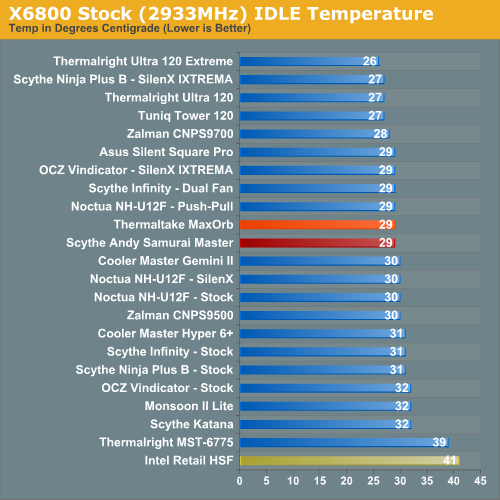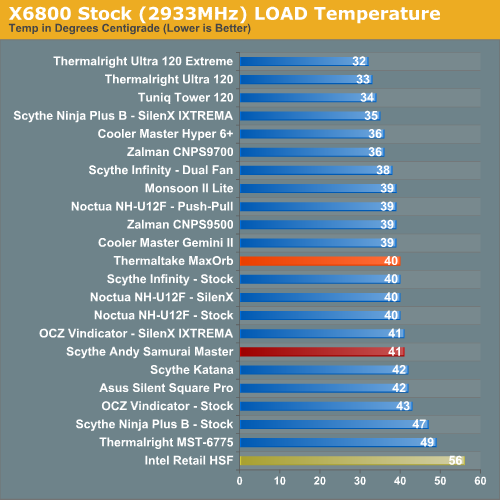Scythe Andy Samurai Master vs. Thermaltake MaxOrb
by Wesley Fink on June 4, 2007 5:00 AM EST- Posted in
- Cases/Cooling/PSUs
Cooling at Stock Speed
Some users will never overclock their CPU, but they still want to run the coolest CPU temperatures possible to enhance stability and extend CPU life. Both the Thermaltake MaxOrb and the Scythe Andy Samurai Master come complete with fans. Therefore we tested both coolers with the supplied fans.

Where the very good Intel stock cooler keeps the X6800 at 41C at idle, the MaxOrb and Andy Samurai both manage 29C, which is a very good performance. This is a significant improvement over the Intel stock cooler, but it is not the best we have tested. The Thermalright coolers, at the top of our heatpipe tower performance charts, cool to 26C and 27C, and the Tuniq 120 maintains 27C. The MaxOrb and Andy Samurai are not the best stock idle coolers we have tested, but they are competitive at the top of stock cooling.
It is more difficult to effectively simulate a computer being stressed by all of the conditions it might be exposed to in different operating environments. For most home users CPU power is most taxed with contemporary gaming. Therefore our stress test simulates running a demanding contemporary game. The Far Cry River demo is looped for 30 minutes and the CPU temperature is captured at 4 second intervals with the NVIDIA monitor "logging" option. The highest temperature during the load test is then reported. Momentary spikes are ignored, as we report a sustained high-level temp that you would expect to find in this recording configuration.
Cooling efficiency of the Scythe Andy Samurai Master and the Thermaltake MaxOrb were compared under load conditions at stock speed to the retail HSF and other recently tested CPU coolers.

The MaxOrb under load at stock speeds reached a maximum temperature of 40C with the embedded fan at high speed. Performance of the Andy Samurai was similar at 41C load temperature at stock speed. This performance compares to the Thermalright coolers at 32C and 33C, the Tuniq at 34C and the Cooler Master Hyper 6+ and Zalman 9700 at 36C. Stock load performance is average at best among tested coolers.
Some users will never overclock their CPU, but they still want to run the coolest CPU temperatures possible to enhance stability and extend CPU life. Both the Thermaltake MaxOrb and the Scythe Andy Samurai Master come complete with fans. Therefore we tested both coolers with the supplied fans.

Where the very good Intel stock cooler keeps the X6800 at 41C at idle, the MaxOrb and Andy Samurai both manage 29C, which is a very good performance. This is a significant improvement over the Intel stock cooler, but it is not the best we have tested. The Thermalright coolers, at the top of our heatpipe tower performance charts, cool to 26C and 27C, and the Tuniq 120 maintains 27C. The MaxOrb and Andy Samurai are not the best stock idle coolers we have tested, but they are competitive at the top of stock cooling.
It is more difficult to effectively simulate a computer being stressed by all of the conditions it might be exposed to in different operating environments. For most home users CPU power is most taxed with contemporary gaming. Therefore our stress test simulates running a demanding contemporary game. The Far Cry River demo is looped for 30 minutes and the CPU temperature is captured at 4 second intervals with the NVIDIA monitor "logging" option. The highest temperature during the load test is then reported. Momentary spikes are ignored, as we report a sustained high-level temp that you would expect to find in this recording configuration.
Cooling efficiency of the Scythe Andy Samurai Master and the Thermaltake MaxOrb were compared under load conditions at stock speed to the retail HSF and other recently tested CPU coolers.

The MaxOrb under load at stock speeds reached a maximum temperature of 40C with the embedded fan at high speed. Performance of the Andy Samurai was similar at 41C load temperature at stock speed. This performance compares to the Thermalright coolers at 32C and 33C, the Tuniq at 34C and the Cooler Master Hyper 6+ and Zalman 9700 at 36C. Stock load performance is average at best among tested coolers.










50 Comments
View All Comments
Wesley Fink - Tuesday, June 5, 2007 - link
We now use a standard quality silver-colored paste in all our reviews. But in our experience and testing the thermal paste makes absolutely no difference in performance. The paste fills gaps and needs to remain fluid and not dry out.A famous review from several years ago showed toothpaste and Kraft Vegimite equal or superior to AS3 - at least until they dried out. The point was use a decent paste but don't obsess on it - as it really makes no difference. This is particularly true now that all the current CPUs use heatspreader covers and you no longer are mounting on a tiny die as you were on AMD Socket A.
rjm55 - Tuesday, June 5, 2007 - link
The review Wesley is talking about was at the Australian site Dan's Data at http://www.dansdata.com/goop.htm">http://www.dansdata.com/goop.htmChunga29 - Monday, June 4, 2007 - link
Whoa! Two articles today? Heh. I was just finishing the 2900 fiasco article and suddenly this shows up. [Big grin!]Only problem with the Hexus article is that overclocking isn't even a factor. I'm a bit confused as to their results, as they have the Zalman 9700 performing in the top of the tested HSFs, trailing the Tuniq by 1C. The AT results show Tuniq leading by 2C at load, but even more interesting is that the AT results are about 10C cooler on every HSF (at least where they overlap).
Oh... WAIT! The Hexus reviews are using a Pentium D Extrene 840!? What in the hell is up with that? Why don't we do some testing with the original Athlon FX-51 while we're at it? While most people won't purchase a $1000 CPU like the X6800, at least Core 2 Duo is very popular and many are OC'ing E6600 chips to similar levels (and beyond). Perhaps the VX is the best HSF when it comes to cooling Pentium D setups... but that's about as far as I'd take the Hexus roundup.
Honestly, I'd like only a few things from AnandTech cooling reviews:
1) Testing on AM2 as well as 775.
2) Temps of various components.
3) More HSFs! Heh. A roundup would be great.
Two HSFs in one ariticle is a start, but how about four or five similar HSFs at a time? Half the material is just filler (copy paste from previous articles), so other than the spec sheets, intro, conclusion, and charts there's not much going on here. Am I the only one that skims (at best) the middle pages?
DrMrLordX - Tuesday, June 5, 2007 - link
Hexus used a Pentium 840D because it's a stupidly hot processor that's cheap. Pentium Ds can easily put out as much heat as Kentsfields.Chunga29 - Tuesday, June 5, 2007 - link
I understand that. The problem is that performance with a Pentium Extreme 840 doesn't really tell you anything about how the cooler will perform with other processors. For what it's worth, a heavily overclocked Core 2 Duo X6800 (or better yet a QX6700) is also a stupidly hot processor. I'd wager that the output of QX6700 easily exceeds the 840EE.Testing with outdated equipment is meaningless, regardless of how hot the old parts get. That's why it would be ideal to see current AM2 performance as well. I remember a LOT of reviews hailing the Zalman 9500 as the greatest cooler ever, and while it appears to do great on AM2 it's pretty average on an overclocked C2D. I hope you can see that the same could easily be true of comparing performance with 840EE to current C2D and AM2 chips.
DrMrLordX - Wednesday, June 6, 2007 - link
Actually, uh, your point isn't really valid. A heavily OCed Smithfield can easily pump out heat like a heavily OCed Kentsfield. Heat is heat as long as its distributed properly by the IHS and properly-applied TIM.The age of the equipment in question is irrelevant unless a particular HSF has a mounting mechanism that is somehow better-suited to one socket or another, not that that's an issue when dealing with Smithfields and Kentsfields (both s775 processors).
Using a Smithfield to test the limit of modern HSFs is entirely appropriate, given its massive heat output that can still rival that of Kentsfields and its socket which is identical to the socket-type used with Conroe and Kentsfield processors.
Stele - Monday, June 4, 2007 - link
I second that, though especially no.(2). That would help decide between a traditional downdraught HSF blowing air onto the motherboard vs. the tower ones.
It might be useful to have a proper cross flow of air through the case too, e.g. one 120mm fan each for intake and exhaust. This would not only be more reflective of regular casing setups but would also ensure a level playing field - otherwise the tower ones may potentially have a greater advantage over the downdraught ones (since they can exhaust hot air out of the case through the case rear) than real-life setups may show.
How about including the Enzotech Ultra-X in a future review? Seems to be quite a good performer by all accounts! :P
Wesley Fink - Monday, June 4, 2007 - link
The MaxOrb is reputed to be at least the equal of the Big Typhoon VX in performance and it is a more recent design.We have an Enzotech Ultra-X in for testing. You will see it in a future review.
We had planned a big spread on board component temperatures, but when the down-facing fans didn't even come close to the heatpipe towers in cooling efficiency or overclcoking it became a moot point. IF the down fans really cooled better they would cool more efficiently and/or allow a higher overclock. Neither is the case in our tests. We run our top OC speed with a pretty hefty chipset voltage increase, and if the dowh-facers cooled components better we would get a better overclock, or at least an equal OC. Instead OC is average at best with all 3 expensive down-face designs.
DrMrLordX - Tuesday, June 5, 2007 - link
Reputed by who? Would it really kill you guys to review the Big Typhoon VX, or an older Big Typhoon with an FM-121?The Big Typhoon has had at least one other good showing here:
http://forum.abit-usa.com/showthread.php?t=103462">http://forum.abit-usa.com/showthread.php?t=103462
It beat the Tuniq Tower 120 pretty solidly there as well once it had a decent fan in it. Note that at least one of the fans that allowed the Big Typhoon to defeat the Tuniq Tower 120 has approxmiately the same cfm rating as the fan included with the Big Typhoon VX.
Chunga29 - Monday, June 4, 2007 - link
Addendum: it might be interesting (although it's too late now) to test with an E6600 instead of the X6800... maybe switch to a Q6600 in the future? When AM2 gets quad core (if it gets quad core?), I'd like to see head-to-head comparisons of HSfs on both platforms. Maybe retest the current leaders for reference (Ultra-120/eXtreme, Tuniq, Hyper6+, and a couple others?)